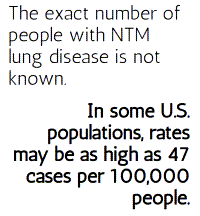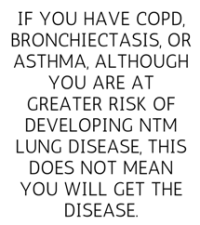NTM Lung Disease: What it is and What you Need to Know
Posted on November 05, 2019 |
This post was authored by Jane Martin, BA, LRT, CRT, Assistant Director of Education at the COPD Foundation.
If you have chronic obstructive pulmonary disease (COPD), you know that it is most often a combination of emphysema and chronic bronchitis. You know it is a chronic, progressive disease with shortness of breath, coughing, wheezing, and tightness in the chest. However, you may not have heard, or know much, about NTM lung disease. It is also a chronic, progressive lung disease that makes it difficult to breathe. In this blog series, you will learn more about NTM lung disease.
What is NTM lung disease?
Nontuberculous mycobacterial (NTM) lung disease is a serious infection caused by bacteria. When it gets into the lungs, NTM bacteria* can invade the cells that are there to protect the lungs from infection. The job of these special cells is to find and eat harmful bacteria, viruses, fungi, and parasites. When this defense system is invaded, it can’t do its job, and that can lead to chronic lung infections and pneumonia. NTM reproduces rapidly and may be difficult to treat. People with NTM lung disease may experience symptoms such as shortness of breath, fever, weight loss, chronic cough, fatigue, and chest pain. Those with NTM lung disease can become seriously ill and may require lengthy hospital stays to manage their condition.
*In this blog from this point on we will refer to “NTM lung disease” when talking about the disease itself, and to simply “NTM” when we talk about the bacteria that causes NTM lung disease.
Could I have NTM lung disease?

Before we go on to learn more, it is important to know that not everyone is at risk of getting NTM lung disease. Individuals with healthy lungs are not likely to develop it. On the other hand, people with chronic lung disorders such COPD, bronchiectasis, and asthma are at greater risk. The damage in their lungs makes them vulnerable to infections such as NTM. In fact, statistics suggest that 50 percent of people with bronchiectasis may have NTM lung disease. And people with COPD are 16 times more likely to get a NTM lung infection. Yet, it’s important to know that not everyone with COPD, bronchiectasis, or asthma will get NTM lung disease. We will learn more about this in our next blog.
What is Bronchiectasis?

Bronchiectasis is a chronic lung disease in which the bronchial airways – the tubes that carry air in and out of the lungs – become widened, scarred, and inflamed. Cilia are tiny hair-like structures lining the airways. They are designed to move mucus up and out of the lungs, just as an escalator moves people up to a higher floor. In bronchiectasis, the cilia don’t work as well as they should, and in some cases they do not work at all.
These changes in the airways can cause mucus to collect, leading to a frequent cough with large amounts of mucus production. In addition, this pooling of mucus in the lungs encourages germs to grow, resulting in more lung infections.
Where does NTM come from?
NTM is commonly found in soil and water in our environment. In the course of our everyday lives, we all come in contact with it. When particles of soil and droplets of water get into the air, we breathe this in. There are many types of bacteria that cause NTM lung disease, but mycobacterium avium complex (MAC) is by far the most common. MAC causes 80% of all NTM lung disease cases in the US. We will talk about the many ways to reduce exposure to NTM in our third blog in this series.
What do bronchiectasis and NTM have in common with COPD?

Like COPD, NTM lung disease and bronchiectasis are chronic, progressive lung diseases that make it difficult to breathe. Also like COPD, the bronchial airways have lost their elasticity – their ability to spring back to their resting size after expanding. Like COPD, NTM lung disease and bronchiectasis can cause cough, mucus production, and serious lung infections. All three of these chronic lung diseases can be managed in a variety of ways. We will learn more about managing the disease in the third blog in this series.
How are bronchiectasis and NTM lung disease different from COPD?

Some people with COPD have a frequent cough with mucus production, some have a dry cough, and others don’t cough at all. NTM lung disease and bronchiectasis, on the other hand, often have a frequent cough with a lot of mucus production. In NTM lung disease and bronchiectasis the airways are not only stretched out, but they can also have pouches where mucus can collect and cause a serious infection. The effects of NTM lead to further deterioration of existing lung conditions, making them even more serious than they normally are in COPD and bronchiectasis without NTM.
Summary
NTM lung disease and bronchiectasis are serious chronic, progressive lung diseases, but can be treated in a variety of ways. It is important to learn about these diseases in addition to being educated in the effective management of COPD.
Stay tuned for an informational video that will tell you more about NTM lung disease!
This blog post is sponsored by Insmed Incorporated.